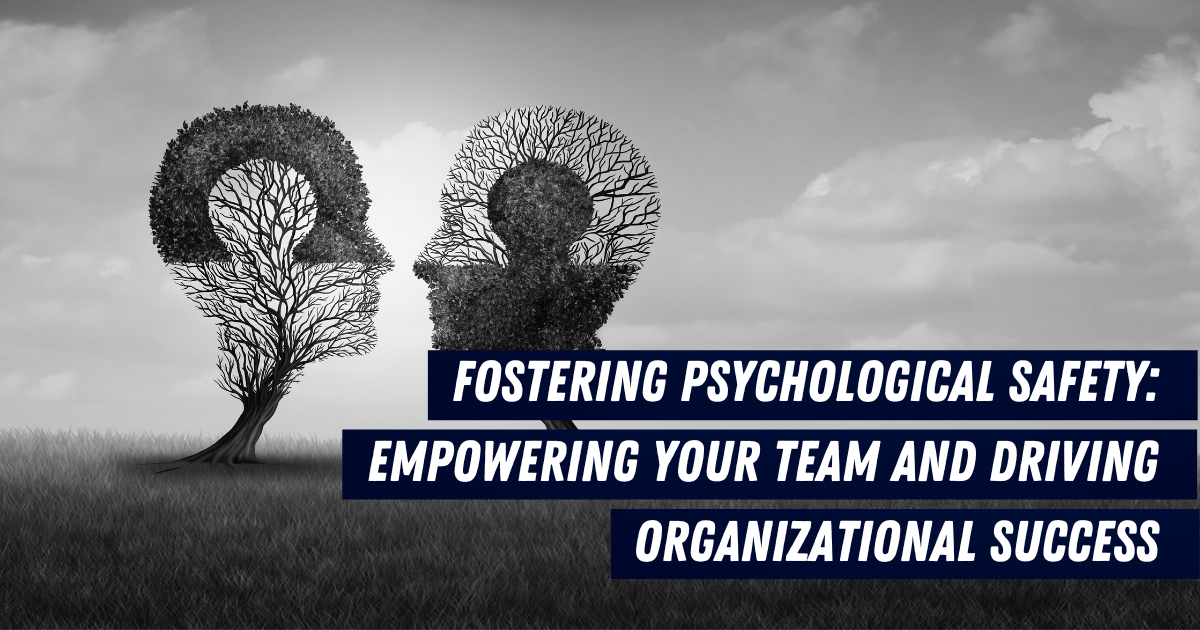Welcome, esteemed mid-senior level leaders! In today’s fast-paced business environment, the success of any organization hinges on the strength of its teams. As an experienced executive leadership coach, I am here to shed light on a crucial aspect that often goes unnoticed but holds immense power—psychological safety in the workplace. In this blog, we will explore why creating a psychologically safe environment is paramount for driving innovation, enhancing collaboration, and ultimately achieving sustainable success. So, let’s dive in!
Understanding Psychological Safety
In order to foster psychological safety in the workplace, it’s crucial to first understand its meaning and impact. Psychological safety refers to the shared belief that one can express ideas, take risks, and be vulnerable without fear of judgment or retribution. This safe environment encourages open communication, enables learning from failure, promotes collaboration, and boosts employee engagement. When employees feel psychologically safe, they are more willing to contribute their unique perspectives, challenge the status quo, and take calculated risks.
Fostering Open and Trusting Communication
One of the key foundations of psychological safety is open and trusting communication. As leaders, you can create an environment that promotes this by valuing and actively seeking diverse perspectives. Encouraging individuals to voice their ideas, opinions, and concerns without fear of negative consequences fosters a culture of inclusion, leading to enhanced problem-solving and innovation. Practicing active listening, where you genuinely seek to understand and empathize with your team members, strengthens relationships, builds trust, and promotes psychological safety. Additionally, establishing a feedback culture that focuses on growth rather than blame allows for continuous improvement and development.

Embracing Failure as a Learning Opportunity
In psychologically safe environments, failure is viewed as a valuable learning opportunity rather than something to be feared or punished. Encourage a growth mindset among your team members and reframe failure as a stepping stone to success. By normalizing mistakes and encouraging experimentation, you remove the fear of taking risks and stifle creativity. Create spaces for sharing lessons learned from failures, emphasizing the importance of reflection and continuous learning. When employees feel supported in their pursuit of innovation and understand that failure is a natural part of the learning process, they become more willing to think outside the box, take calculated risks, and contribute their best ideas.
Building a Supportive and Inclusive Environment

A psychologically safe workplace is one that empowers individuals and embraces their unique contributions. To cultivate this environment, provide your team members with autonomy and ownership of their work. Granting them the freedom to make decisions and take responsibility for their projects instills a sense of empowerment, leading to increased engagement and productivity. Additionally, it is crucial to foster a culture of respect and appreciation, where achievements are recognized and celebrated. Acknowledging both individual and team accomplishments, no matter how big or small, contributes to a positive work environment, strengthens team cohesion, and reinforces psychological safety. Lastly, encourage vulnerability by modeling it yourself. When leaders demonstrate authenticity and vulnerability, it creates a safe space for team members to share their challenges, seek support, and develop resilience.
Conclusion
As mid-senior level leaders, you have the power to shape your organization’s culture and create a workplace where psychological safety thrives. By fostering open and trusting communication, embracing failure as a learning opportunity, and building a supportive and inclusive environment, you can empower your teams to reach their full potential and drive organizational success.
Remember, psychological safety is not a one-time effort but an ongoing journey. Invest time and effort into creating an environment that values and nurtures the well-being and growth of your employees, and you will witness the positive impact it has on your team’s performance and your organization’s bottom line.
Want to learn how to create a culture your employees will thrive in? Reach out to us Schedule a call or video conference with Christopher Lawrence or call us right now at 1-844-910-7111.

Additional Reading
To further expand your knowledge on psychological safety and its role in leadership, I recommend the following resources:
- “The Fearless Organization: Creating Psychological Safety in the Workplace for Learning, Innovation, and Growth” by Amy C. Edmondson: This book provides a comprehensive understanding of psychological safety and offers practical strategies for fostering it within teams and organizations.
- “Dare to Lead: Brave Work. Tough Conversations. Whole Hearts.” by Brené Brown: In this book, Brené Brown explores the importance of vulnerability, courage, and empathy in leadership, all of which are essential elements for creating psychological safety.
- “Radical Candor: Be a Kick-Ass Boss Without Losing Your Humanity” by Kim Scott: Kim Scott introduces the concept of radical candor, which emphasizes honest and direct communication while maintaining a supportive and caring environment. This approach contributes to psychological safety by promoting open dialogue and trust.
By delving into these materials, you will gain valuable insights and practical strategies to implement in your leadership journey. Additionally, consider seeking out other reputable blogs and articles that focus on leadership, psychological safety, and fostering a positive work culture.
Remember, cultivating psychological safety is an investment that reaps remarkable rewards, both for your teams and for your organization as a whole. So, take the leap and embrace the power of psychological safety in your workplace!
References
“Fostering Psychological Safety: Empowering Your Team and Driving Organizational Success.” Retrieved from [insert link to ADP article or blog post].
Edmondson, A. C. (2018). The Fearless Organization: Creating Psychological Safety in the Workplace for Learning, Innovation, and Growth.
Brown, B. (2018). Dare to Lead: Brave Work. Tough Conversations. Whole Hearts.
Scott, K. (2017). Radical Candor: Be a Kick-Ass Boss Without Losing Your Humanity.



